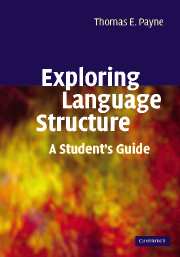Book contents
- Frontmatter
- Contents
- List of figures
- List of tables
- Preface
- Acknowledgments
- A note on transcriptions
- List of abbreviations
- 1 Introduction to morphology and syntax
- 2 Morphological processes and conceptual categories
- 3 Morphophonemics
- 4 Word classes
- 5 Exploring subclasses
- 6 Constituent structure
- 7 Language typology
- 8 Grammatical relations
- 9 Voice and valence
- 10 Multi-clause constructions
- Glossary
- References
- Subject and language Index
5 - Exploring subclasses
Published online by Cambridge University Press: 05 June 2012
- Frontmatter
- Contents
- List of figures
- List of tables
- Preface
- Acknowledgments
- A note on transcriptions
- List of abbreviations
- 1 Introduction to morphology and syntax
- 2 Morphological processes and conceptual categories
- 3 Morphophonemics
- 4 Word classes
- 5 Exploring subclasses
- 6 Constituent structure
- 7 Language typology
- 8 Grammatical relations
- 9 Voice and valence
- 10 Multi-clause constructions
- Glossary
- References
- Subject and language Index
Summary
As mentioned in the previous chapter, every language has subclasses within the major word classes. Subclasses exist when some stems in a class have different grammatical properties from others. There are many reasons why subclasses exist, and those reasons may not be obvious to a linguist who is learning the language for the first time, so it is a matter of grammatical analysis to determine what the subclasses are, and, if possible, determine their motivations, i.e., the reasons why they exist. As we will see in the next section, some subclasses are motivated by structure, and others by function. Some are motivated by a combination of structure and function, while still others have no apparent motivation whatsoever.
An example of a structure-based subclassification would be the three conjugation classes of verbs in Spanish. Verbs in Spanish take different endings depending on whether the infinitive form of the verb ends in -ar, -ir, or -er. There is no meaning feature or set of features that correlates with the various classes. An example of a function-based subclassification would be certain zero-plural nouns in English, such as deer, fish, elk, sheep, etc. While there are no obvious structural similarities among nouns that take the zero plural, it turns out that there is a meaning, or functional, correlation – most of these nouns refer to animals that are traditionally hunted for food.
- Type
- Chapter
- Information
- Exploring Language StructureA Student's Guide, pp. 133 - 151Publisher: Cambridge University PressPrint publication year: 2006



